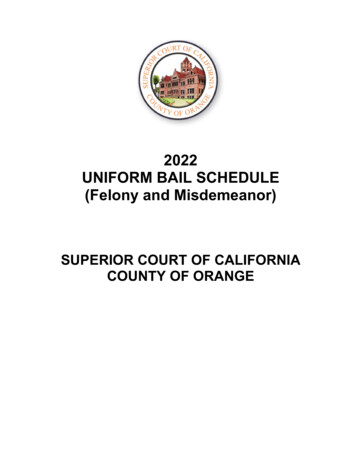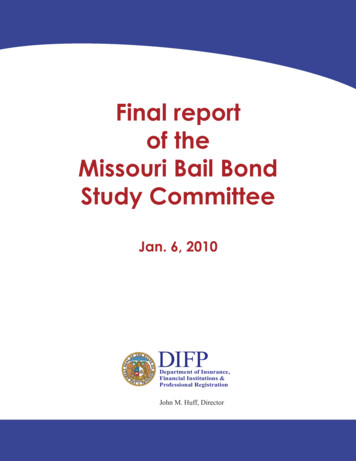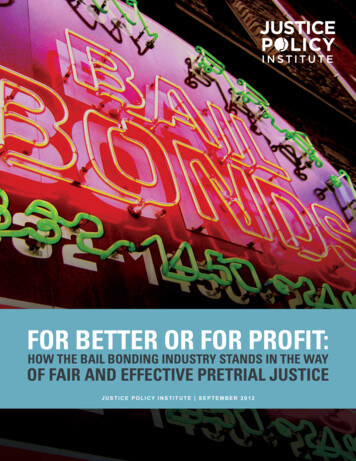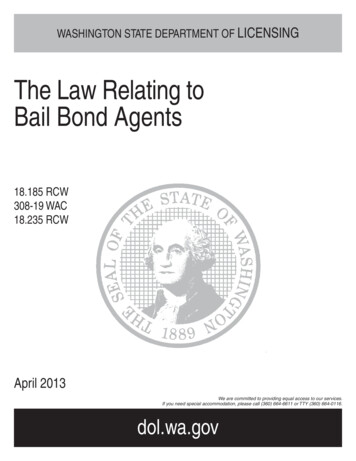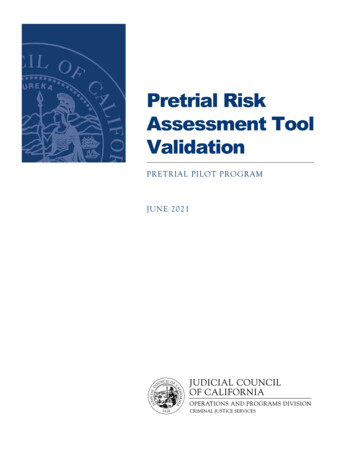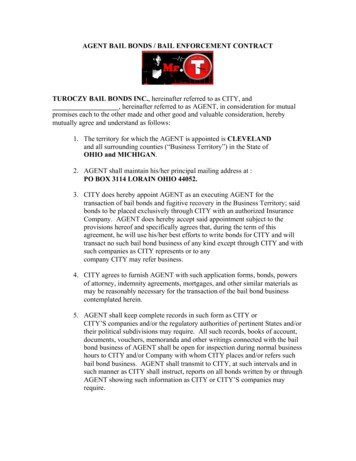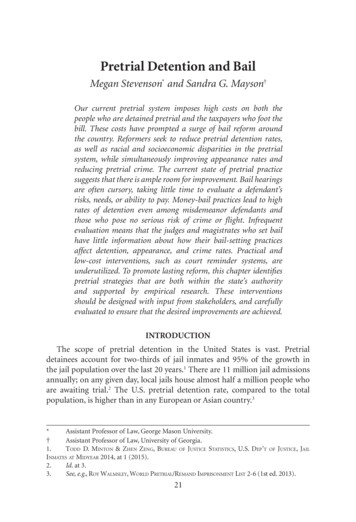
Transcription
Pretrial Detention and BailMegan Stevenson* and Sandra G. Mayson†Our current pretrial system imposes high costs on both thepeople who are detained pretrial and the taxpayers who foot thebill. These costs have prompted a surge of bail reform aroundthe country. Reformers seek to reduce pretrial detention rates,as well as racial and socioeconomic disparities in the pretrialsystem, while simultaneously improving appearance rates andreducing pretrial crime. The current state of pretrial practicesuggests that there is ample room for improvement. Bail hearingsare often cursory, taking little time to evaluate a defendant’srisks, needs, or ability to pay. Money-bail practices lead to highrates of detention even among misdemeanor defendants andthose who pose no serious risk of crime or flight. Infrequentevaluation means that the judges and magistrates who set bailhave little information about how their bail-setting practicesaffect detention, appearance, and crime rates. Practical andlow-cost interventions, such as court reminder systems, areunderutilized. To promote lasting reform, this chapter identifiespretrial strategies that are both within the state’s authorityand supported by empirical research. These interventionsshould be designed with input from stakeholders, and carefullyevaluated to ensure that the desired improvements are achieved.INTRODUCTIONThe scope of pretrial detention in the United States is vast. Pretrialdetainees account for two-thirds of jail inmates and 95% of the growth inthe jail population over the last 20 years.1 There are 11 million jail admissionsannually; on any given day, local jails house almost half a million people whoare awaiting trial.2 The U.S. pretrial detention rate, compared to the totalpopulation, is higher than in any European or Asian country.3*Assistant Professor of Law, George Mason University.Assistant Professor of Law, University of Georgia.1.Todd D. Minton & Zhen Zeng, Bureau of Justice Statistics, U.S. Dep’t of Justice, JailInmates at Midyear 2014, at 1 (2015).2.Id. at 3.3.See, e.g., Roy Walmsley, World Pretrial/Remand Imprisonment List 2-6 (1st ed. 2013).†21
22Reforming Criminal JusticePretrial detention has profound costs. In fiscal terms, the total annual costof pretrial jail beds is estimated to be 14 billion, or 17% of total spending oncorrections.4 At the individual level, pretrial detention can result in the lossof employment, housing or child custody, in addition to the loss of freedom.Pretrial detention also affects case outcomes. No fewer than five empiricalstudies published in the last year, deploying quasi-experimental design, haveshown that pretrial detention causally increases a defendant’s chance ofconviction, as well as the likely sentence length.5 The increase in convictionsis primarily an increase in guilty pleas among defendants who otherwisewould have had their charges dropped. The plea-inducing effect of detentionundermines the legitimacy of the criminal justice system itself—especially ifsome of those convicted are innocent. Finally, two recent studies have foundevidence that pretrial detention increases the likelihood that a person willcommit future crime.6 This may be because jail exposes defendants to negativepeer influence,7 or because it has a destabilizing effect on defendants’ lives.Given the costs of pretrial detention, one might expect that detentiondecisions would be made with care. This is not how the system currentlyoperates. For the most part, whether a person is detained pretrial dependssolely on whether he can afford the bail amount set in his case. Nationwide, 9out of 10 felony defendants who were detained pretrial in 2009 (the last yearfor which the data is published) had bail set and would have been released if4.Pretrial Justice Inst., Pretrial Justice: How Much Does It Cost? 2 (2017); Melissa S.Kearney et al., The Hamilton Project, Ten Economic Facts about Crime and Incarceration in theUnited States 13 (2014).5.See, e.g., Will Dobbie, Jacob Goldin & Crystal Yang, The Effects of Pretrial Detention onConviction, Future Crime, and Employment: Evidence from Randomly Assigned Judges 3 (Nat’lBureau of Econ. Research, Working Paper No. 22511, 2016), www.nber.org/papers/w22511; ArpitGupta, Christopher Hansman & Ethan Frenchman, The Heavy Costs of High Bail: Evidence fromJudge Randomization 22 (Columbia Law & Econ. Working Paper No. 531, 2016), http://ssrn.com/abstract 2774453; Paul Heaton, Sandra Mayson & Megan Stevenson, The DownstreamConsequences of Misdemeanor Pretrial Detention, 69 Stan. L. Rev. 711 (2017); Emily Leslie &Nolan G. Pope, The Unintended Impact of Pretrial Detention on Case Outcomes: Evidencefrom NYC Arraignments 34-35 (July 20, 2016) (unpublished manuscript), available at http://home.uchicago.edu/ npope/pretrial paper.pdf; Megan Stevenson, Distortion of Justice: Howthe Inability to Pay Bail Affects Case Outcomes (January 12, 2016) (unpublished manuscript),available at pta et al., supra note 5; Heaton et al., supra note 5. But see Stevenson, supra note 5(finding no future-crime effects); Dobbie et al., supra note 5 (same).7.Patrick Bayer et al., Building Criminal Capital Behind Bars: Peer Effects in Juvenile Corrections,124 Q. J. Econ. 105, 105 (2009); Megan Stevenson, Breaking Bad: Social Influence and the Path toCriminality in Juvenile Jails 1 (2015) (unpublished manuscript) (on file with author).
Pretrial Detention and Bail23they had posted it.8 Even at relatively low bail amounts, detention rates arehigh. In Philadelphia, between 2008 and 2013, 40% of defendants with bailset at 500 remained jailed pretrial.9 Over the same time period in Houston,more than half of all misdemeanor defendants were detained pending trial;their average bail amount was 2,786.10 Some pretrial detainees are facing veryserious charges, but most are not: At least as of 2002, 65% of pretrial detaineeswere held on nonviolent charges only, and 20% were charged with minorpublic-order offenses.11 The hearings at which bail is set—and which have suchserious consequences—are typically rapid and informal.In the last few years, the hefty costs of pretrial detention have generatedgrowing interest in bail reform. Jurisdictions around the country are nowrewriting their pretrial law and policy. They aspire to reduce pretrial detentionrates, as well as racial and socioeconomic disparities in the pretrial system,without increasing rates of non-appearance or pretrial crime. The overarchingreform vision is to shift from the “resource-based” system of money bail toa “risk-based” system, in which pretrial interventions are tied to risk ratherthan wealth.12 To accomplish this, jurisdictions are implementing actuarial riskassessment and reducing the use of money bail as a mediator of release. Theidea is that defendants who pose little statistical risk of flight (i.e., fleeing thejurisdiction) or committing pretrial crime can be released without money bailor onerous conditions. Riskier defendants can be released under supervision,and detention can be reserved for those so likely to flee or commit seriousharm that the risk cannot be managed in any less intrusive way. (In practice,however, risk-assessment tools do not actually measure flight- and crime-risk;rather, they measure nonappearance- and arrest-risk, a point discussed atgreater length below.)This chapter offers a critical discussion of central pretrial reform initiatives,drawing on recent scholarship. We hope to provide readers with a deeperunderstanding of ongoing academic and policy debates around key reform goals:reducing the use of money bail, reducing racial disparities in pretrial detention,8.Brian A. Reaves, Bureau of Justice Statistics, U.S. Dep’t of Justice, Felony Defendants inLarge Urban Counties, 2009—Statistical Tables 1, 15 (2013).9.Stevenson, supra note 5, at 12.10.Heaton et al., supra note 5, at 736 tbl. 1.11.Doris S. James, Bureau of Justice Statistics, U.S. Dep’t of Justice, Profile of Jail Inmates,2002, at 3 (2004).12.See, e.g., Christopher Moraff, U.S. Cities Are Looking for Alternatives to Cash Bail, NextCity (Mar. 24, 2016), es-cash-bail; PretrialJustice Inst., Rational and Transparent Bail Decision Making: Moving From a Cash-Based to aRisk-Based Process (2012).
24Reforming Criminal Justiceevaluating risk of crime or flight, rationalizing pretrial detention, and tailoringconditions of release. In each area, we note the current direction of reform, surveyrelevant scholarship, and offer our own perspective on the best prospects foreffective and lasting change. We evaluate pretrial reform initiatives on the basisof several criteria: effectiveness in promoting public safety and court appearance,intrusiveness to individual liberty, cost, and impact on racial and socioeconomicdisparity.13 Part I provides background. Part II is our substantive discussion. Thechapter concludes with recommendations based on key reform priorities.I. THE PRETRIAL SYSTEMA. STRUCTURE AND HISTORYThe pretrial phase begins when a judicial officer or grand jury determinesthat there is probable cause to support a criminal charge, and it ends whenthe charge is adjudicated or dismissed. Once the state has charged someone,it has a strong interest in ensuring the integrity of the ensuing proceeding—including ensuring that the defendant appears in court and does not interferewith witnesses or evidence. The state also has an interest, as it always does,in preventing future crime, and some defendants may be particularly crimeprone. So the core goals of the pretrial system are to (1) ensure defendants’appearance, (2) prevent obstruction of justice, and (3) prevent other pretrialcrime, all while minimizing intrusions to defendants’ liberty.14Since the turn of the 20th century, the primary mechanism for ensuringdefendants’ appearance has been money bail, or a “secured financial bond.”15 Adefendant deposits the specified bail amount with the court as security for hisappearance at future proceedings. If he does appear, the deposit is returned at theconclusion of the case. This system has inspired three waves of reform. The first,in the 1960s, sought to reduce the pretrial detention of the poor by limiting the13.For further guidance on bail reform, see, for example, Am. Bar Ass’n, Standards forCriminal Justice: Pretrial Release (3d ed. 2007) [hereinafter ABA Standards]; Crim. Just. Pol’yProgram, Harvard Law School, Moving Beyond Money: A Primer on Bail Reform (2016);Timothy R. Schnacke, Fundamentals of Bail: A Resource Guide for Pretrial Practitioners anda Framework for American Pretrial Reform 21-44 (2014); and The Solution, Pretrial JusticeInst., http://www.pretrial.org/solutions (last visited Mar. 25, 2017). The general principles thesesources articulate represent broadly held views among contemporary reformers, policymakersand academics.14.ABA Standards, supra note 13, § 10-1.1.15.See Schnacke, supra note 13, at 21-40. Prior to that time, the system relied on theunsecured pledges of personal sureties. Id.; cf. William Blackstone, 4 Commentaries on the Lawsof England 296 (1769) (explaining that an accused required to give bail must “put in securitiesfor his appearance, to answer the charge against him”).
Pretrial Detention and Bail25use of money bail in favor of unsecured release (“release on recognizance”).16 Butrising crime during the 1970s and 1980s prompted a second reform movement,this time directed at incapacitating dangerous defendants.17 The Bail ReformAct of 1984 authorized federal courts to order pretrial detention without bailon the basis of a defendant’s dangerousness.18 Many states followed suit. Everyjurisdiction except New York also authorized courts to consider public safetyin imposing bail or other conditions of release.19 More recently, money bail hasbeen on the rise and rates of release on recognizance have declined.20 The currentwave of reform seeks to reverse that trend.B. CURRENT PRACTICEIn practice, bail hearings are a messy affair. Every person who is arrested isentitled to a judicial determination, within 48 hours, that there is probable causeto believe she has committed a crime.21 Many jurisdictions combine this witha bail hearing (or “pretrial release hearing”). It is common for such hearingsto last only a few minutes. They are often held over videoconference with nodefense counsel present. The presiding official may be a magistrate rather thana judge, and may not even be a lawyer. Available evidence suggests that the bailjudges do not often take the time to make a careful determination about whatbail an arrestee can realistically afford. Some jurisdictions use bail schedules thatprescribe a set bail amount for each offense.22 In others, statutory law directsjudges to consider various factors in imposing bail or alternative conditions ofrelease.23 These statutes provide little guidance about how to weigh the factors,or which conditions of release are appropriate to manage different pretrial risks.16.See, e.g., John S. Goldkamp, Danger and Detention: A Second Generation of Bail Reform, 76J. Crim. L. & Criminology 1, 2 (1985).17.See generally id.18.Bail Reform Act of 1984, Pub. L. No. 98-473, 98 Stat. 1976-87 (codified at 18 U.S.C.§§ 3141-50, 3062).19.Goldkamp, supra note 16, at 56 & n.57.20.Thomas H. Cohen & Brian A. Reaves, Bureau of Justice Statistics, U.S. Dep’t of Justice,Pretrial Release of Felony Defendants in State Courts 2 (2007) (reporting that from 19901994, 41% of pretrial releases were on recognizance and 24% were by cash bail; from 2002-2004,23% of releases were on recognizance and 42% were by cash bail); Reaves, supra note 8, at 15(“Between 1990 and 2009, the percentage of pretrial releases involving financial conditions rosefrom 37% to 61%.”).21.Cty. of Riverside v. McLaughlin, 500 U.S. 44, 58 (1991); Gerstein v. Pugh, 420 U.S. 103, 126(1975).22.Pretrial Justice Inst., Pretrial Justice in America: A Survey of County Pretrial ReleasePolicies, Practices and Outcomes 7 (2009) (reporting that 64% of surveyed counties use a bailschedule).23.See, e.g., Lauryn P. Gouldin, Disentangling Flight Risk from Dangerousness, 2016 B.Y.U. L.Rev. 837, 866 (describing state statutes).
26Reforming Criminal JusticeIn most cases, a monetary bail amount is set, and in most cases, the defendantneed not pay it directly to be released. Three mechanisms have developed forsubsidizing bail. The dominant one is the commercial bail bond industry.24Commercial bail bondsmen charge defendants a non-refundable fee—usuallyaround 10% of the total bail amount—for the service of posting the bond.Because of concern about the effect of this industry on defendants’ incentiveto appear and on the fairness of the process, some jurisdictions have outlawedit. Others have developed their own partial-deposit systems, which allowdefendants to obtain release by depositing only a percentage of the total bailamount with the court.25 A third, less common, mechanism is the communitybail fund: a nonprofit organization that posts bail on defendants’ behalf.26C. LAW AND POLICYThe Supreme Court has affirmed that “[i]n our society liberty is the norm,and detention prior to trial or without trial is the carefully limited exception.”27 Aset of federal constitutional provisions protect pretrial liberty. Most importantly,perhaps, the Equal Protection and Due Process Clauses prohibit the state fromconditioning a person’s liberty on payment of an amount that she cannot affordunless it has no other way to achieve an important state interest.28 Since 2015, anumber of federal district courts have held that fixed money-bail schedules, which24.Cohen & Reaves, supra note 20, at 4 (showing that 48% of all pretrial releases studiedwere based on financial conditions, most of which—33% of all releases—were on surety bond);About Us, Am. Bail Coalition, www.americanbailcoalition.org (last visited Jan. 31, 2017) (“TheAmerican Bail Coalition is a trade association made up of national bail insurance companies .”).25.E.g., Eric Helland & Alexander Tabarrok, The Fugitive: Evidence on Public Versus PrivateLaw Enforcement From Bail Jumping, 47 J.L. & Econ. 93, 94 (2004).26.See Jocelyn Simonson, Bail Nullification, 115 Mich. L. Rev. 585, 600 (2017) (noting thatcommunity bail funds have proliferated recently, motivated by “beliefs regarding the overuse ofpretrial detention”).27.United States v. Salerno, 481 U.S. 739, 755 (1987).28.See, e.g., Bearden v. Georgia, 461 U.S. 660, 672-73 (1983) (holding that to “deprive theprobationer of his conditional freedom simply because, through no fault of his own, he cannotpay the fine . would be contrary to the fundamental fairness required by the FourteenthAmendment”); see also Statement of Interest of the United States at 1, Varden v. City of Clanton,No. 2:15-cv-34-MHT-WC (M.D. Ala., Feb. 13, 2015) (“Incarcerating individuals solely becauseof their inability to pay for their release . violates the Equal Protection Clause of the FourteenthAmendment.”) (citing Tate v. Short, 401 U.S. 395, 398 (1971)); Williams v. Illinois, 399 U.S. 235,240-41 (1970); Smith v. Bennett, 365 U.S. 708, 709 (1961)). But see Brief for Amici Curiae Am.Bail Coalition et al., Walker v. Calhoun, No. 16-10521 (11th Cir. June 21, 2016) (arguing that thisline of case law has no application in the pretrial context).
Pretrial Detention and Bail27do not take ability to pay into account, violate these provisions.29 Relatedly, theEighth Amendment prohibits “excessive” bail.30 This requires an individualizedbail determination: Bail must be “reasonably calculated” to ensure the appearanceof a particular defendant.31 The Bail Clause permits detention without bail, butmay prohibit any burden on a defendant’s liberty that is excessive “in light ofthe perceived evil” it is designed to address.32 The Due Process Clause prohibitspretrial punishment.33 It also requires that any detention regime be carefullytailored to achieve the state’s interest and include robust procedural protectionsfor the accused.34 The Fourth Amendment prohibits any “significant restraint”on pretrial liberty in the absence of probable cause for the crime charged.35 TheSixth Amendment, finally, requires that counsel be appointed for an indigentdefendant at or soon after her initial appearance in court.36 It remains an openquestion whether defendants have a Sixth Amendment right to representation atthe bail hearing itself.3729.Pierce v. City of Velda City, 4:15-cv-570-HEA (E.D. Mo. June 3, 2015); Jones v. City ofClanton, 2:15-cv-34-MHT (M.D. Ala. Sept. 14, 2015); Thompson v. Moss Point, Miss., 1:15-cv00182-LG-RHW (S.D. Miss. Nov. 6, 2015); Walker v. City of Calhoun, Ga., 4:15-cv-170-HLM(N.D. Ga. Jan. 28, 2016); ODonnell v. Harris Cty., 4:16-cv-01414 (S.D. Tex. Apr. 28, 2017). TheDepartment of Justice took the same position under the Obama Administration. See Brief forthe United States as Amicus Curiae Supporting Plaintiff-Appellee and Urging Affirmance of theIssue Addressed Herein at 3, Walker v. City of Calhoun, No. 16-10521-HH (11th Cir. Aug. 18,2016); Letter from Vanita Gupta, Principal Deputy Assistant Att’y Gen., Civil Rights Div., Dep’tof Justice, and Lisa Foster, Director, Office for Access to Justice, to Colleagues 7 (Mar. 14, load.30.U.S. Const. amend. VIII (“[E]xcessive bail shall not be required.”).31.Stack v. Boyle, 342 U.S. 1, 5 (1951).32.United States v. Salerno, 481 U.S. 739, 754-55 (1987).33.Id. at 748-52.34.Id. at 747, 75052. The Supreme Court upheld the federal pretrial detention regime against(among other things) a procedural due process challenge on the ground that it provided for anadversarial hearing, guaranteed defense representation, required that the state prove “by clearand convincing evidence that an arrestee presents an identified and articulable threat,” directedthat the court make “written findings of fact” and “reasons for a decision to detain,” and providedimmediate appellate review. Id. at 751-52.35.Gerstein v. Pugh, 420 U.S. 103, 125 (1975); Manuel v. City of Joliet, 137 S. Ct. 911, 914(2017).36.Rothgery v. Gillespie Cty., 554 U.S. 191, 199, 212 (2008).37.See id. at 212 n.15 (reserving judgment on that question). For a discussion of indigentdefense, see Eve Brensike Primus, “Defense Counsel and Public Defense,” in the present Volume.
28Reforming Criminal JusticeBeyond the federal Constitution, federal statutory law and state law regulatepretrial practice. In the federal system, the Bail Reform Act lays out acomprehensive pretrial scheme.38 At the state level, there is wide variation inpretrial legal frameworks. Approximately half of state constitutions include aright to release on bail in noncapital cases. The other half allow for detentionwithout bail in much broader circumstances.39 Most states also have statutesthat structure pretrial decision-making.In the policy realm, the American Bar Association has codified standards onpretrial release that represent the mainstream consensus among scholars about bestpractices in the pretrial arena.40 Three core principles are worth highlighting. First,wealth cannot be the factor that determines whether someone is released or detainedpretrial.41 Secondly, money bail should be set only to mitigate flight risk (not threatsto public safety) and as a last resort.42 Finally, the state should always use the leastrestrictive means available to mitigate flight or crime risk.43Ultimately, though, it is local implementation that truly shapes pretrialpractice. There is huge variance across counties with respect to the timing ofbail hearings, the presence of counsel, the qualifications and training of bailjudges, the resources allocated for bail hearings, the prevalence of commercialbondsmen, the customary standards for bail-setting, and the availability ofalternatives to detention or money bail.II. PRETRIAL REFORM INITIATIVESA. REDUCING THE USE OF MONEY BAILReducing reliance on monetary bail is a central goal of many pretrial reformadvocates.44 The use of money bail, by definition, disadvantages the poor; peoplewho have resources or access to credit are more likely to be released than thosewho do not. This fact is not only unjust. It also means that money-bail systemsthat do not meaningfully account for defendants’ ability to pay are inefficient atmanaging flight- and crime-risk, and likely to be unconstitutional.45 Althoughimplementing procedures to assess defendants’ ability to pay may help, it isdifficult to assess accurately.38.39.40.41.42.43.44.45.18 U.S.C. §§ 3141-50, 3062.Wayne R. LaFave et al., 4 Criminal Procedure § 12.3(b) (3d ed. 2000).See generally ABA Standards, supra note 13.Id. at 42 (§ 10-1.4(c)-(e)), 110 (§10-5.3).Id. at 110.Id. at 106 (§ 10-5.2).To be precise, the core goal is to reduce the use of secured money bonds.See supra notes 28-31 and accompanying text.
Pretrial Detention and Bail29It is possible to operate an effective pretrial system with minimal reliance onmoney bail. The District of Columbia, for instance, has been running its pretrialsystem largely without it since the 1960s. Nearly all D.C. defendants are releasedon recognizance or with nonmonetary conditions; a small percentage are ordereddetained. For the last six years, appearance rates have remained at or above 87%and rearrest rates at or below 12%—better than national averages.46Replicating the D.C. model is no easy feat, however. The District benefits from anexperienced and well-funded pretrial services agency. Without that infrastructure,limiting or eliminating money bail is likely to reduce appearance rates as well.Such initiatives should therefore be paired with alternative methods of ensuringappearance, such as court reminders or an expansion of pretrial services.B. REDUCING RACIAL DISPARITIES IN DETENTION RATESBlack defendants make up 35% of the pretrial detainee population despiteconstituting only 13% of the U.S. population.47 A second core objective of pretrialreform is to reduce this racial disparity in pretrial detention. In order to pursuethis goal effectively, it is important to understand how such disparities arise.First, arrest itself, as well as criminal-history information, may reflectracially disparate past practices.48 For example, residents of heavily policedminority neighborhoods are arrested for drug offenses at disproportionatelyhigh rates relative to the rate of offending.49 Even superficially colorblindmethods of making pretrial custody decisions will embed these disparities.This is not an easy problem to fix, as actual criminal behavior is unmeasurableand decision-making in criminal justice has long relied on the criminalrecord as its proxy. Nonetheless, educating judges about this type ofdisparity (or using sophisticated risk-assessment algorithms to adjust for it)may alleviate the problem.46.See Pretrial Services Agency for D.C., Congressional Budget Justification andPerformance Budget Request Fiscal Year 2017, at 1, 23 (Feb. 2016). Nationally, 16% of releaseddefendants were rearrested and 17% missed a court date in 2009, the last year for which data ispublished. Reaves, supra note 8, at 20-21.47.Minton & Zeng, supra note 1, at 3.48.For discussions of the issue, see David A. Harris, “Racial Profiling,” in Volume 2 of thepresent Report; Jeffrey Fagan, “Race and the New Policing,” in Volume 2 of the present Report;Henry F. Fradella & Michael D. White, “Stop-and-Frisk,” in Volume 2 of the present Report; andDevon W. Carbado, “Race and the Fourth Amendment,” in Volume 2 of the present Report.49.See, e.g., Shima Baradaran & Frank McIntyre, Race, Prediction and Pretrial Detention, 10J. Empirical L. Stud. 741, 759 (2013); Drug Policy Alliance, The Drug War, Mass Incarcerationand Race (2014).
30Reforming Criminal JusticeSecondly, bail judges may harbor explicit or implicit racial bias, which is tosay that they may set higher bail or place more onerous conditions of releaseon minority defendants than otherwise similar white defendants.50 A typicalapproach to measuring this type of bias is to see whether minority defendantshave higher bail than white defendants after controlling for variables likecharge type, criminal history, and age. Using this approach, many studies havefound evidence of bias.51 As the number and specificity of controls increase,however, this measure of bias tends to shrink or disappear. Baradaran andMcIntyre found no evidence that judges set bail higher for black defendantsthan white defendants once defendants’ specific charge and criminal historywere accounted for.52 Stevenson found no evidence that bail is systematically sethigher or lower for black defendants in Philadelphia, conditional on the chargeand criminal record.53 While racial bias certainly exists, differential treatmentof similarly situated defendants on the basis of race may not be a substantialcontributor to racial disparities in pretrial detention.Third, racial disparities may result from differing levels of wealth or access tocredit across races. For example, Stevenson found that, in Philadelphia, only 46%of black defendants with bail set at 5,000 (and who need only to pay a 500 depositin order to be released) post bail, compared to 56% of non-black defendants.54Stevenson estimated that 50% of the race gap in detention rates in Philadelphiais accounted for by differences in the likelihood of posting bail. The other 50% isdue to the fact that black defendants in this dataset are, on average, facing moreserious charges, have lengthier criminal records, and accordingly have higher bailset.55 Similarly, Demuth found that black defendants do not have bail set at higherlevels than white defendants, but concluded that the odds of detention for blacksare almost twice as large because they are less likely to post bail.56 To the extent thatracial disparities in pretrial detention rates are a direct function of socioeconomicdisparity, reducing reliance on money bail should lessen them.50.For discussions of the role of race in court decisionmaking, see Paul Butler, “Race andAdjudication,” in the present Volume.51.See, e.g., Marvin D. Free, Jr., Bail and Pretrial Release Decisions: An Assessment of theRacial Threat Perspective, 2 J. Ethnicity in Crim. Just. 23, 31-33 (2004); Besiki Luka Kutateladze& Nancy R. Andiloro, Prosecution and Racial Justice in New York County—Technical Reportii–iii (2014), aradaran & McIntyre, supra note 49.53.Stevenson, supra note 5 (manuscript at 23).54.Id. (manuscript at 4).55.Id. (manuscript at 25).56.Stephen Demuth, Racial and Ethnic Decisions in Pretrial Release and Outcomes, 41Criminology 874, 894 (2003) (finding that Hispanics generally have a higher bail set than whites,although that could be due to citizenship status).
Pretrial Detention and Bail31Finally, racial disparities in pretrial detention rates can arise from disparitiesin charged offenses and past criminal records across racial groups that reflectactual differences in rates of criminal offending. It is extremely difficult toisolate this source of disparity. But to the extent that differential crime ratescontribute to racial disparities in pretrial detention, the only long-term solutionis to redress the underlying causes of the divergent rates.C. IMPROVING PRETRIAL PROCESSPretrial reform necessarily entails some changes to pretrial process. Thefollowing five approaches hold particular promise.1. Release before the bail hearingJurisdictions can reduce the number of people who require a bail hearingin the first place by increasing the use of citation rather than arrest, and byauthorizing direct release from the police station (station-house release).57The process of arrest is obtrusive, time-consuming, expensive, and potentiallydamaging to community-police relations. Jurisdictions suc
Pretrial Detention and Bail Megan Stevenson* and Sandra G. Mayson† Our current pretrial system imposes high costs on both the people who are detained pretrial and the taxpayers who foot the bill. These costs have prompted a surge of bail reform around the country. Reformers seek to reduce pretrial detention rates,



